-
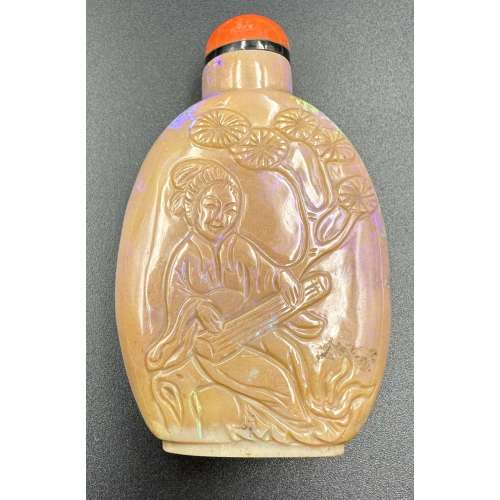 Opal jasper snuff bottle carved in low relief with a beauty playing Guqin under a pine tree and another on the veranda with a folding fan; bamboo, pine, and plum (the three friends of winter); carnelian agate stopper and black collar. Mid-20th century Dimensions: H67 x W41 x D15 mm
Opal jasper snuff bottle carved in low relief with a beauty playing Guqin under a pine tree and another on the veranda with a folding fan; bamboo, pine, and plum (the three friends of winter); carnelian agate stopper and black collar. Mid-20th century Dimensions: H67 x W41 x D15 mm -
 Colour (tone) lithography, image 396 x 508 mm, sheet 532 x 654 mm; before signature, undated; pencil ms inscription: Föhrenhain — E. Pelikan / 200M to the lower-right corner of the sheet. Contributor: Emilie Mediz-Pelikan (Austrian, 1861 – 1908) – artist. Seller's description: Austrian-German painter and graphic artist. Emilie Mediz-Pelikan was born in Vöcklabruck in 1861. She studied at the Vienna Academy and followed her teacher Albert Zimmermann to Salzburg and in 1885 to Munich. In 1891 she married the painter and graphic artist Karl Mediz (1868 - 1945), with whom she lived in Vienna and from 1894 in Dresden. She was in contact with the Dachau Artists' Colony and went on study trips to Paris, Belgium, Hungary and Italy. In the Dachau artists' colony she was friends with Adolf Hölzel and Fritz von Uhde. In 1889 and 1890 she spent time in Paris and in the Belgian artists' colony Knokke. In 1898 she was represented at the first art exhibition of the Vienna Secession, and in 1901 at the International Art Exhibition in Dresden. In 1903 she and her husband had a group exhibition, at the Hagenbund in Vienna. In 1904, she showed graphic works at the Dresden royal court art dealer Richter, and in 1905 and 1906 she exhibited at the Berlin Künstlerhaus. It was not until around 1900 that she achieved her artistic breakthrough with her landscape paintings. Since the estate of the artist, who died prematurely in Dresden in 1908, was lost in the former GDR until the 1980s, it was quite late that the artist was rediscovered and revalued both in Austrian art history and on the art market. In 1986, the first major exhibitions took place at the Upper Austrian State Museum and the University of Applied Arts in Vienna, followed by numerous smaller exhibitions in private galleries in Vienna, Linz and Munich. The artist received recognition during her lifetime from numerous prominent fellow painters as well as from the art critic Ludwig Hevesi. Together with Tina Blau, Herbert Boeckl, Marie Egner, Theodor von Hörmann, Franz Jaschke, Eugen Jettel, Ludwig Heinrich Jungnickel, Rudolf Junk, Gustav Klimt, Oskar Kokoschka, Johann Victor Krämer, Heinrich Kühn, Carl Moll, Rudolf Quittner, Rudolf Ribarz, Emil Jakob Schindler, Max Suppantschitsch, Max Weiler, Olga Wisinger-Florian and Alfred Zoff, she was a protagonist of the reception of Impressionism in Austria. This style went down in Austrian art history under the term "Stimmungsimpressionismus".
Colour (tone) lithography, image 396 x 508 mm, sheet 532 x 654 mm; before signature, undated; pencil ms inscription: Föhrenhain — E. Pelikan / 200M to the lower-right corner of the sheet. Contributor: Emilie Mediz-Pelikan (Austrian, 1861 – 1908) – artist. Seller's description: Austrian-German painter and graphic artist. Emilie Mediz-Pelikan was born in Vöcklabruck in 1861. She studied at the Vienna Academy and followed her teacher Albert Zimmermann to Salzburg and in 1885 to Munich. In 1891 she married the painter and graphic artist Karl Mediz (1868 - 1945), with whom she lived in Vienna and from 1894 in Dresden. She was in contact with the Dachau Artists' Colony and went on study trips to Paris, Belgium, Hungary and Italy. In the Dachau artists' colony she was friends with Adolf Hölzel and Fritz von Uhde. In 1889 and 1890 she spent time in Paris and in the Belgian artists' colony Knokke. In 1898 she was represented at the first art exhibition of the Vienna Secession, and in 1901 at the International Art Exhibition in Dresden. In 1903 she and her husband had a group exhibition, at the Hagenbund in Vienna. In 1904, she showed graphic works at the Dresden royal court art dealer Richter, and in 1905 and 1906 she exhibited at the Berlin Künstlerhaus. It was not until around 1900 that she achieved her artistic breakthrough with her landscape paintings. Since the estate of the artist, who died prematurely in Dresden in 1908, was lost in the former GDR until the 1980s, it was quite late that the artist was rediscovered and revalued both in Austrian art history and on the art market. In 1986, the first major exhibitions took place at the Upper Austrian State Museum and the University of Applied Arts in Vienna, followed by numerous smaller exhibitions in private galleries in Vienna, Linz and Munich. The artist received recognition during her lifetime from numerous prominent fellow painters as well as from the art critic Ludwig Hevesi. Together with Tina Blau, Herbert Boeckl, Marie Egner, Theodor von Hörmann, Franz Jaschke, Eugen Jettel, Ludwig Heinrich Jungnickel, Rudolf Junk, Gustav Klimt, Oskar Kokoschka, Johann Victor Krämer, Heinrich Kühn, Carl Moll, Rudolf Quittner, Rudolf Ribarz, Emil Jakob Schindler, Max Suppantschitsch, Max Weiler, Olga Wisinger-Florian and Alfred Zoff, she was a protagonist of the reception of Impressionism in Austria. This style went down in Austrian art history under the term "Stimmungsimpressionismus". -
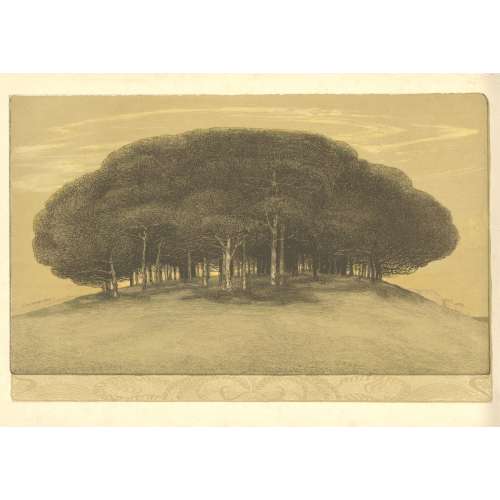 Colour (tone) lithography, image 268 x 410 mm, sheet 317 x 470 mm; signed on bottom-left of the image “Pelikan 1905”, and pencil ms inscription: E. Pelikan to the lower-right corner of the sheet. Contributor: Emilie Mediz-Pelikan (Austrian, 1861 – 1908) – artist. Seller's description: Austrian-German painter and graphic artist. Emilie Mediz-Pelikan was born in Vöcklabruck in 1861. She studied at the Vienna Academy and followed her teacher Albert Zimmermann to Salzburg and in 1885 to Munich. In 1891 she married the painter and graphic artist Karl Mediz (1868 - 1945), with whom she lived in Vienna and from 1894 in Dresden. She was in contact with the Dachau Artists' Colony and went on study trips to Paris, Belgium, Hungary and Italy. In the Dachau artists' colony she was friends with Adolf Hölzel and Fritz von Uhde. In 1889 and 1890 she spent time in Paris and in the Belgian artists' colony Knokke. In 1898 she was represented at the first art exhibition of the Vienna Secession, and in 1901 at the International Art Exhibition in Dresden. In 1903 she and her husband had a group exhibition, at the Hagenbund in Vienna. In 1904, she showed graphic works at the Dresden royal court art dealer Richter, and in 1905 and 1906 she exhibited at the Berlin Künstlerhaus. It was not until around 1900 that she achieved her artistic breakthrough with her landscape paintings. Since the estate of the artist, who died prematurely in Dresden in 1908, was lost in the former GDR until the 1980s, it was quite late that the artist was rediscovered and revalued both in Austrian art history and on the art market. In 1986, the first major exhibitions took place at the Upper Austrian State Museum and the University of Applied Arts in Vienna, followed by numerous smaller exhibitions in private galleries in Vienna, Linz and Munich. The artist received recognition during her lifetime from numerous prominent fellow painters as well as from the art critic Ludwig Hevesi. Together with Tina Blau, Herbert Boeckl, Marie Egner, Theodor von Hörmann, Franz Jaschke, Eugen Jettel, Ludwig Heinrich Jungnickel, Rudolf Junk, Gustav Klimt, Oskar Kokoschka, Johann Victor Krämer, Heinrich Kühn, Carl Moll, Rudolf Quittner, Rudolf Ribarz, Emil Jakob Schindler, Max Suppantschitsch, Max Weiler, Olga Wisinger-Florian and Alfred Zoff, she was a protagonist of the reception of Impressionism in Austria. This style went down in Austrian art history under the term "Stimmungsimpressionismus".
Colour (tone) lithography, image 268 x 410 mm, sheet 317 x 470 mm; signed on bottom-left of the image “Pelikan 1905”, and pencil ms inscription: E. Pelikan to the lower-right corner of the sheet. Contributor: Emilie Mediz-Pelikan (Austrian, 1861 – 1908) – artist. Seller's description: Austrian-German painter and graphic artist. Emilie Mediz-Pelikan was born in Vöcklabruck in 1861. She studied at the Vienna Academy and followed her teacher Albert Zimmermann to Salzburg and in 1885 to Munich. In 1891 she married the painter and graphic artist Karl Mediz (1868 - 1945), with whom she lived in Vienna and from 1894 in Dresden. She was in contact with the Dachau Artists' Colony and went on study trips to Paris, Belgium, Hungary and Italy. In the Dachau artists' colony she was friends with Adolf Hölzel and Fritz von Uhde. In 1889 and 1890 she spent time in Paris and in the Belgian artists' colony Knokke. In 1898 she was represented at the first art exhibition of the Vienna Secession, and in 1901 at the International Art Exhibition in Dresden. In 1903 she and her husband had a group exhibition, at the Hagenbund in Vienna. In 1904, she showed graphic works at the Dresden royal court art dealer Richter, and in 1905 and 1906 she exhibited at the Berlin Künstlerhaus. It was not until around 1900 that she achieved her artistic breakthrough with her landscape paintings. Since the estate of the artist, who died prematurely in Dresden in 1908, was lost in the former GDR until the 1980s, it was quite late that the artist was rediscovered and revalued both in Austrian art history and on the art market. In 1986, the first major exhibitions took place at the Upper Austrian State Museum and the University of Applied Arts in Vienna, followed by numerous smaller exhibitions in private galleries in Vienna, Linz and Munich. The artist received recognition during her lifetime from numerous prominent fellow painters as well as from the art critic Ludwig Hevesi. Together with Tina Blau, Herbert Boeckl, Marie Egner, Theodor von Hörmann, Franz Jaschke, Eugen Jettel, Ludwig Heinrich Jungnickel, Rudolf Junk, Gustav Klimt, Oskar Kokoschka, Johann Victor Krämer, Heinrich Kühn, Carl Moll, Rudolf Quittner, Rudolf Ribarz, Emil Jakob Schindler, Max Suppantschitsch, Max Weiler, Olga Wisinger-Florian and Alfred Zoff, she was a protagonist of the reception of Impressionism in Austria. This style went down in Austrian art history under the term "Stimmungsimpressionismus". -
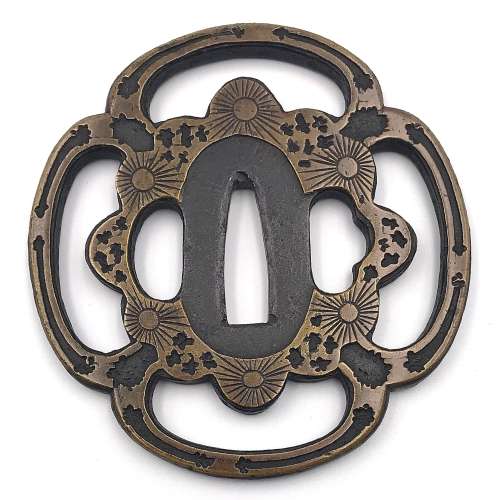
Iron tsuba of mokkō form (mokkōgata) pierced (sukashi) and inlaid with precast dark brass inlay (taka-zōgan) with somewhat abstract/geometrical design that can be liberally described as pines, mist, and snow.
Momoyama or early Edo period. End of the 16th - beginning of the 17th century. Heianjō school. Unsigned. Dimensions: 86.8 x 82.9 x 4.5 mm. -
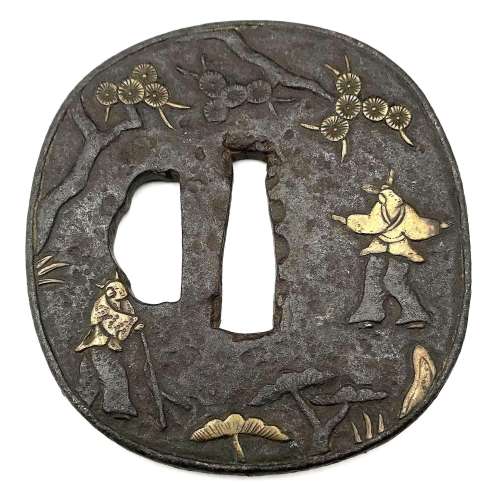 Relatively thick iron tsuba of rounded square form with slightly elevated rim decorated in carving (sukidashi-bori) and yellow brass (shinchū) inlay (suemon-zōgan) with legendary creatures (humans with cow heads) in a pine tree forrest on the face, and a horned man with a stick hunting a rabbit in the woods on the reverse. Large hitsu-ana possibly cut off later on. In the beginning of the 20th century such tsuba were usually attributed to Fushimi-Kaga school. This one may be attributed to either Ōnin or to Heianjō. The latter seems most plosible because of the thick web and dull patina. The technique may also be called "shinchū-zōgan". Momoyama or early Edo period. Unsigned. Dimensions: 72.3 x 68.4 x 4.1 mm
Relatively thick iron tsuba of rounded square form with slightly elevated rim decorated in carving (sukidashi-bori) and yellow brass (shinchū) inlay (suemon-zōgan) with legendary creatures (humans with cow heads) in a pine tree forrest on the face, and a horned man with a stick hunting a rabbit in the woods on the reverse. Large hitsu-ana possibly cut off later on. In the beginning of the 20th century such tsuba were usually attributed to Fushimi-Kaga school. This one may be attributed to either Ōnin or to Heianjō. The latter seems most plosible because of the thick web and dull patina. The technique may also be called "shinchū-zōgan". Momoyama or early Edo period. Unsigned. Dimensions: 72.3 x 68.4 x 4.1 mm -
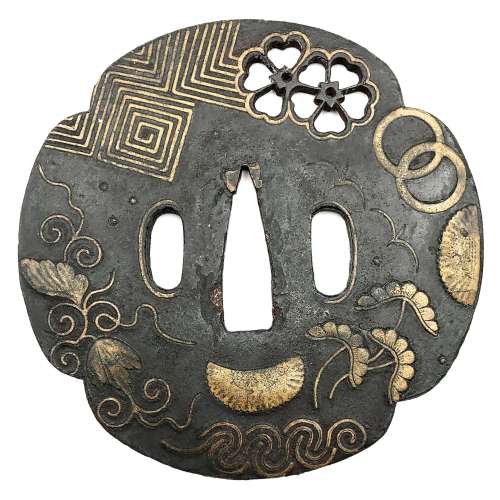 Iron tsuba of mokko form (quatrefoil) decorated with a pair of cherry blossoms (sakura) in small openwork (ko-sukashi) and inlaid in brass (suemon-zōgan) with designs of waves, distant pines, chrysanthemum flowers in halves, tendrils and leaves, lightning or thunder symbol (inazuma), flying geese and family chrests (mon): two interlocked rings (wachigai) on the face, and three encircled stripes (maru-no-uchi-ni-mitsuhikiryo) - kamon of the Kikkawa clan - on the reverse. Hitsu-ana outlined with inlay of brass wire. Surface treated with lacquer. Copper sekigane. Though some consider this type of tsuba to resemble Heianjo school, “...the brass trim around the hitsu-ana is a characteristics of Ōnin work” [Japanese sword guards. Onin – Heianjo – Yoshiro. Gary D. Murtha. GDM Publications, 2016; p. 27.]. The Ōnin origin is reinforced by scattered ten-zōgan elements here and there through the plate. It is possible that the tsuba was initially of round form and later trimmed to mokko shape. Mid Muromachi period; 15th century. Dimensions: Height: 87.2 mm; Width: 87.9 mm; Thickness at seppa-dai: 3.6 mm.
Iron tsuba of mokko form (quatrefoil) decorated with a pair of cherry blossoms (sakura) in small openwork (ko-sukashi) and inlaid in brass (suemon-zōgan) with designs of waves, distant pines, chrysanthemum flowers in halves, tendrils and leaves, lightning or thunder symbol (inazuma), flying geese and family chrests (mon): two interlocked rings (wachigai) on the face, and three encircled stripes (maru-no-uchi-ni-mitsuhikiryo) - kamon of the Kikkawa clan - on the reverse. Hitsu-ana outlined with inlay of brass wire. Surface treated with lacquer. Copper sekigane. Though some consider this type of tsuba to resemble Heianjo school, “...the brass trim around the hitsu-ana is a characteristics of Ōnin work” [Japanese sword guards. Onin – Heianjo – Yoshiro. Gary D. Murtha. GDM Publications, 2016; p. 27.]. The Ōnin origin is reinforced by scattered ten-zōgan elements here and there through the plate. It is possible that the tsuba was initially of round form and later trimmed to mokko shape. Mid Muromachi period; 15th century. Dimensions: Height: 87.2 mm; Width: 87.9 mm; Thickness at seppa-dai: 3.6 mm.


